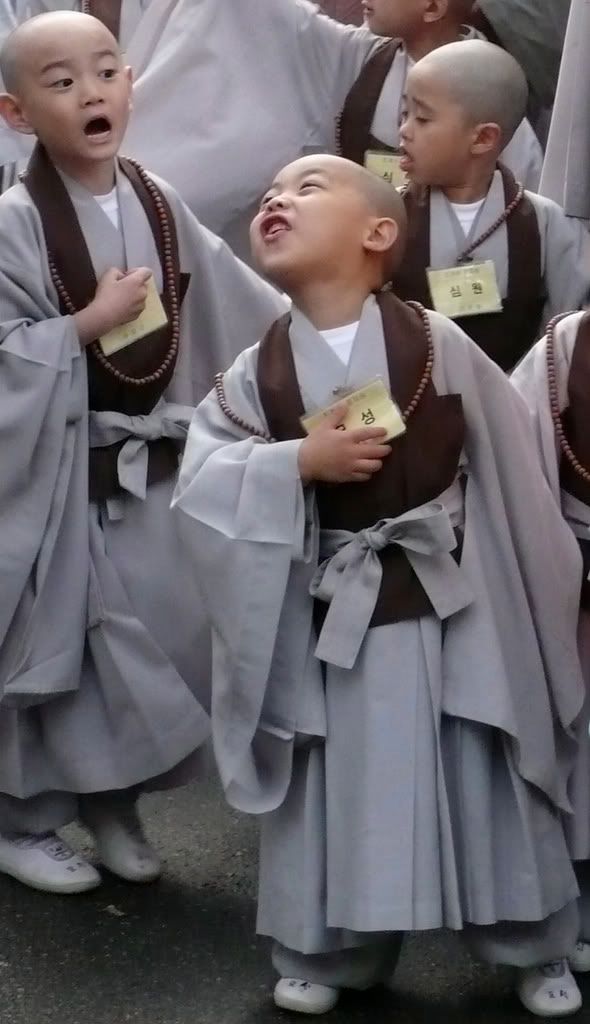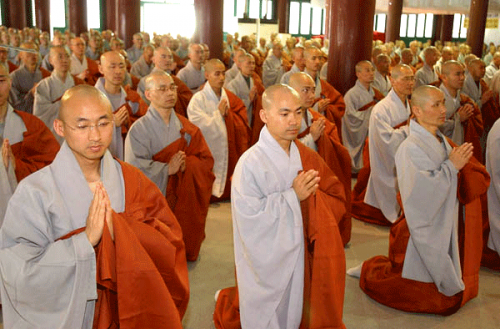Spotting a monk in the vast city of Seoul is not difficult. You will occasionally see one asking for psalms on a street corner while tapping on a hollow wooden bell. For hiking enthusiasts going up any hill or mountain in Korea, you would inevitably find yourself near a temple with monks mulling about dressed all in grey.
It isn't clear exactly when Buddhism was introduced to the Korean peninsula but it was brought in by travelling monks from China. It was only after the King's nephew became a martyr of the new religion in 527 AD that Buddhism took a foothold in the Shilla Kingdom in ancient Korea.
When Buddhist monks from India first passed through China, the converted Chinese opted to dress in grey and not the yellow as worn by their Indian teachers. Another modification they chose to make was to cover up the one bare shoulder which would have been scandalous in conservative China. Considered a sign of respect in India, many sub-tropical Buddhist regions such as South East Asia and South Asia had their monks continue baring the one shoulder. That style of dress is more accommodating to the torrid weather but not so for the colder climates of East Asian countries. Although Chinese monks have since adopted yellow among other colours for their robles, Korean monks have stayed true to the neutral grey.
Korean Buddhist monks will normally wear a grey baggy outfit for their everyday working clothes which look somewhat like the traditional men's hanbok (outfit). Sometimes they will add on a dark red outer layer worn off one shoulder imitating the original Indian dress. It is used normally for ceremonial purposes.
Every colour worn by monks from Buddhist countries has some significance in the faith. Yellow is the colour of equanimity or intelligence. Gherva, a kind of burnt brick red worn by ancient philosophers from India, signifies the five elements: fire, earth, water, and wind. And grey is the combination of all colours and the colour of ashes which we will all be in the end.
by Paula Kim








Dear Sir/Madam,
ReplyDeleteRe: Request for permission to use your picture
We would like to request for your permission to use a picture from your website: http://i357.photobucket.com/albums/oo14/kimchikorea/traditional%20stuff/KoreanBuddhistMonks.png as teaching material in our secondary history book series entitled: Travelling Through History. This series of textbooks follows closely the history syllabus prepared by the Hong Kong Curriculum Development Council. This book will be published in June 2011.
The above noted picture is attached for your reference.
In addition to the print format, we would also like to feature this picture in an accompanying CD-Rom, which is a replication of the above noted in electronic format. Available free of charge only to those who have purchased the print format, the CD-Rom is a complementary resource that allows users of the printed book the convenience of viewing the contents on their personal computers. We would like to emphasis that the said CD-Rom forms part of, and is not separate from, the total archival files of the print edition.
It is our opinion that the above noted picture would be of benefit to teachers as a teaching resource, and to students in terms of enhancing their historical knowledge. Due acknowledgement of your kindness would be made in our skills book series.
We shall be pleased to come to a suitable arrangement with the owner. Should you have any requests or enquiries, please feel free to e-mail me at akilee@aristo.com.hk.
Thank you in advance for your consideration. We look forward to hearing from you in due course.
Yours sincerely
Aki Lee
Assistant editor, History Department
Aristo Educational Press Ltd.